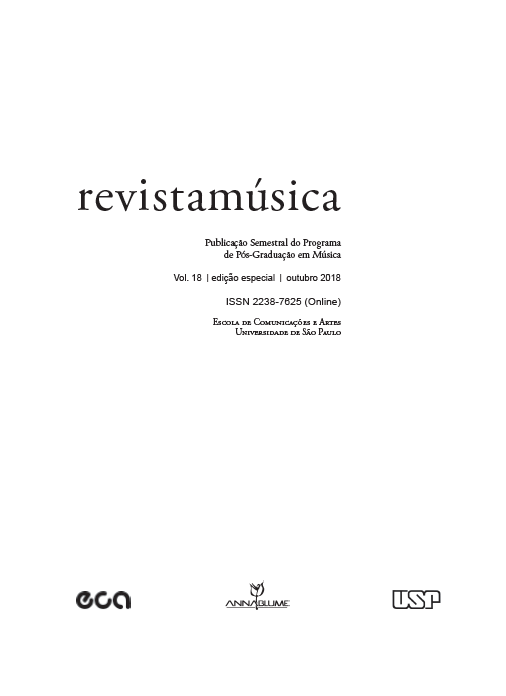The eighteenth century musical discourse
Rhetorical emulations in the oeuvre of Francesco Geminiani (1687-1762)
DOI:
https://doi.org/10.11606/rm.v18iespecial.151085Keywords:
Francesco Geminian, musical rethoric, taste, affectionsAbstract
In the literature of seventeenth and eighteenth centuries, hundreds of treatises on musical composition, performance, pedagogy and speculation were published and widespread throughout European continent. Those works, which vary enormously in regard to the methodology used by their authors, often use to bring the notion of music as analogue to the verbal speech, both guided by the rules of rhetoric, which its aim is to instruct, delight and move its listener. In the case of Francesco Geminiani (1687-1762), the same idea can be read in his treatises, mainly in Rules for playing in a true taste (c. 1748), A treatise of good taste in the art of musick (1749) and The art of playing on the violin (1751). In those works, the author has not only got himself connected to the currents of thought of his time, represented by Batteux, Hume and Montesquieu – in philosophy – and by Quantz, C. P. E. Bach and L. Mozart – in music –, but also recovered meanings of oral, written and delivered speech, present amongst the classics De Oratore, by Cicero, and Institutio Oratoria, by Quintilian. It will be observed that, in relation to eighteenth century philosophical and musical debates on Taste – commonplace in his treatises –, Geminiani is based on the recovery and the discussion of several precepts about imagination, judgement, decorum, ornamentation, performance and reception, approached by the above-mentioned authors. It is therefore evident his view of musical composition mirrored on rhetorical discourse.
Downloads
Downloads
Published
Issue
Section
License
Copyright (c) 2018 Marcus Held

This work is licensed under a Creative Commons Attribution-NonCommercial-ShareAlike 4.0 International License.
Autores que publicam nesta revista concordam com os seguintes termos:
- Autores mantém os direitos autorais e concedem à revista o direito de primeira publicação, com o trabalho simultaneamente licenciado sob a CC Attribution-NonCommercial-ShareAlike 4.0 que permite o compartilhamento do trabalho com reconhecimento da autoria e publicação inicial nesta revista.
- Autores têm autorização para assumir contratos adicionais separadamente, para distribuição não-exclusiva da versão do trabalho publicada nesta revista (ex.: publicar em repositório institucional ou como capítulo de livro), com reconhecimento de autoria e publicação inicial nesta revista.
- Autores têm permissão e são estimulados a publicar e distribuir seu trabalho online (ex.: em repositórios institucionais ou na sua página pessoal) a qualquer ponto antes ou durante o processo editorial, já que isso pode gerar alterações produtivas, bem como aumentar o impacto e a citação do trabalho publicado (Veja O Efeito do Acesso Livre).


